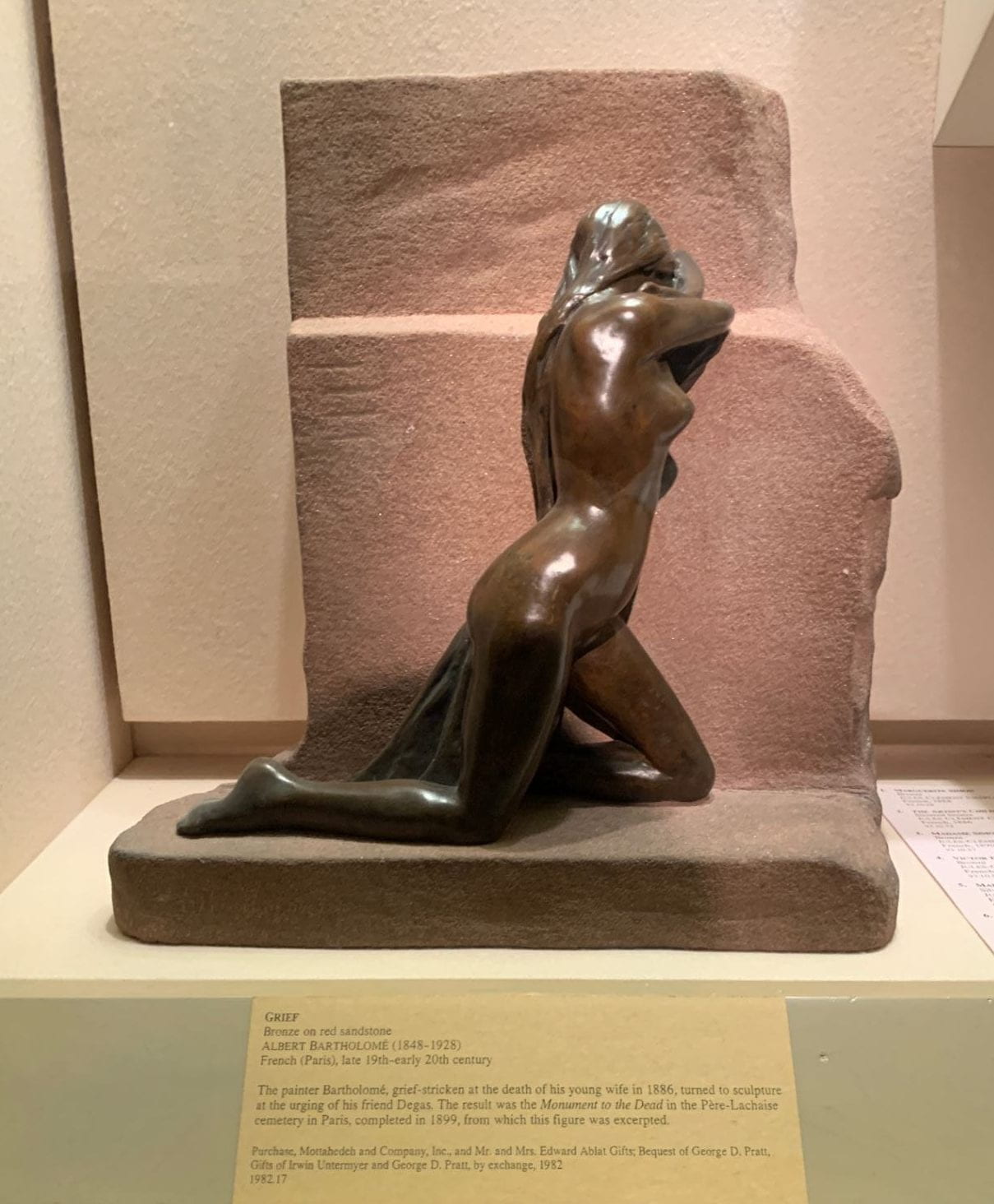Grief
Albert Bartholome (1848 – 1928)
French (Paris), late 19th-early 20th century
Bronze on red sandstone
Grief is a bronze sculpture on sandstone, made by the painter, Albert Bartholome, which is on display at The Metropolitan Museum of Art in New York. Bartholome created this work as he lamented the death of his young wife in 1886. This sculpture is excerpted from the Monument to the Dead in the Pere-Lachaise cemetery in Paris. The female figure is sculpted in dark metal, her face buried in the crook of her arm as she is on her knees, turned away from the viewer leaning on a wall behind her.
The woman’s body language is a key indicator to the emotion Bartholome sets out to capture. The woman is posed on her knees, her left leg positioned more forwards than her right, almost as if she is lunging. She leans forward, as she faces the stone support behind her, head aimed down into her arms. Her back arches, the curve of her spine following the same direction as her left leg, and her abdomen dips towards the ground. The complexity of her stance portrays vivid movement as she grieves. The concept that she is on her knees is symbolic of weakness, the grief she feels causing her to let her guard down. Her wide stance represents how she struggles to carry herself along with her emotional distress, legs set apart to try and stop herself from completely falling to the ground. The way her upper body is sculpted gives her movement as though she just fell to the floor, and is lurching forwards and could fall at any moment. Her right shoulder is sharply defined, the muscle tensed as she uses that arm to cover her face while she leans on the support behind her.
Bartholome seems to pay more attention to the woman’s body rather than face, meaning this was most likely not a portrait of a specific woman, but rather to depict the heavy emotion he felt when creating the sculpture. The woman’s face is actually completely hidden, a choice that draws a viewer away from identifying the model, but allows more focus on what she is doing, which in this case is grieving. The woman rests her head on her left shoulder as she looks away and downwards, while both arms wrap around her head. Because she leans to her left, her hair follows in suit, as it drapes down the left side of her body stopping at her lower back. She hides behind her arms, restricting anyone from seeing her expression. This action acts as a barrier between the subject and viewer, allowing her privacy while she is distraught. She has no identifiable facial features since she is covering them, backing up the notion that this sculpture is not supposed to be portraying an individual.
Aside from the woman’s body features that signify the emotion Bartholome sets out to portray, the colors and materials of the sculpture are qualities to take into consideration. The sculpture was originally placed in a cemetery, a fitting location due to the reason it was created. The support structure actually looks like a tombstone, which supports the idea that the woman is leaning on the grave of the one she’s lost, lamenting for the person. The stark contrast between the support structure and the female figure is important, because it gives the sculpture depth, allowing the woman the stand out. While the support is made of a softer light colored sandstone, the woman is a dark bronze. The textures between the two are harmonious, the metal giving the skin a smoother and more believable look against the grainier rock. The color of her body can be paralleled to funeral attire, where mourners wear dark colors to pay respect. These stylistic choices add to the sculpture’s success of accurately portraying Bartholome’s perception of grieving.
This piece of art coincides with the ideas that artists followed during the Romanticism art movement. Artists explored how to convey emotion and think more imaginatively when art making, highlighting the importance of the individual. This sculpture is exemplementry in showing how artists in the Romanticism movement can portray their own ideas. Bartholome took a very intimate and raw moment, and shaped it into art, allowing spectators to witness how he interpreted his personal loss. Through Grief, Bartholome demonstrates his ability to encapsulate the painful emotions he felt when mourning his wife.
